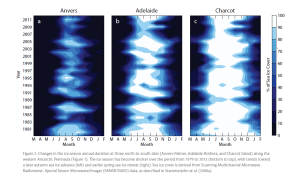Things to do when you’re iced in:
- Finish all non-sampling work for the next month.
- Really commit to the NYT crossword puzzle.
- Make a gingerbread model of Palmer Station.
- Help the carpenter epoxy new pipes for the fuel line.
- Call the Cafe Shirreff field camp for the daily communications check.
- Look online for jobs.
- Catch up on the news.
- Mess up your secret holiday craft project.
- Tell yourself every day that you’ll go to the gym, but don’t actually go.
- Shoot a horror movie scene.
With the solstice occurring last week, we’re really at the height of summer, making it all the more surprising that the sea ice returned and stuck around so long. Below is a figure* showing annual sea ice extent from the Palmer Station/Anvers Island study area (far left), as well as study areas further south (middle and right). Check out the “D” for December, and you can see how rare extensive sea ice cover is at this time of year.
Though not depicted on the figure, during summer 2013, Palmer saw an extremely late sea ice retreat, without all the open water we had this November–it will be interesting to see these “anomalies” in a long-term context.
For now, at least, the sea ice surrounding station has retreated, and we have resumed sampling, seeing a distinct drop in productivity of the local bacteria and phytoplankton communities. It makes sense: after being starved of sunlight by ice cover for ten days, it will take a while for their populations to rebound.
In other news, happy holidays! I was amazed to find, on the first night of Chanukah, a beautiful menorah constructed about eight years ago by the station maintenance specialist, Ben. When I asked what inspired him to build the menorah, he confessed, “The Jewish girl on station was cute.”
A few days later, on Solstice, the ice began breaking up, and we celebrated by polar plunging (jumping into the ocean, or in this case lowering yourself in between floes), and then engaging in what we’ve taken to calling a “civilized plunge,” in which you take a dip in a tank filled with fresh seawater right next to the hot tub. One advantage to the civilized plunge is that it’s much more conducive to sitting than the swaying shore. Working up from 30 seconds, my record time is currently two minutes in the tank, and I’m not sure I’m interested in beating it. Being in the water isn’t as bad, it turns out, as warming back up, when you can really tell that human bodies aren’t made for such cold water.
For Christmas, we had our second two-day weekend of the summer season, the highlight of which was a white elephant gift exchange with incredible handmade projects: cutting boards, picture frames, earrings, mittens and scarves, a travel cribbage board, caramels, and more. We also had visits from many animals: what we termed the “Christmas whales,” humpbacks that breached in front of station during lunch, one leopard seal that haunted the floating dock for twenty minutes as we watched from the boathouse deck, another that popped up between our Zodiac and the penguin researcher we were trying to pick up, and a Chinstrap penguin that hopped up onto the pontoon of Bruiser during our Christmas Day sampling.
Now, we have a big week ahead, with two cruise ship visits Thursday and Friday, the Gould arriving Saturday for a frenzied 24-hour port call, and of course, the beginning of 2015. Happy almost-New Year!
* Figure Source:
Ducklow, H.W., W.R. Fraser, M.P. Meredith, S.E. Stammerjohn, S.C. Doney, D.G. Martinson,
S.F. Sailley, O.M. Schofield, D.K. Steinberg, H.J. Venables, and C.D. Amsler. 2013. West
Antarctic Peninsula: An ice-dependent coastal marine ecosystem in transition.
Oceanography 26(3):190–203, http://dx.doi.org/10.5670/oceanog.2013.62.

